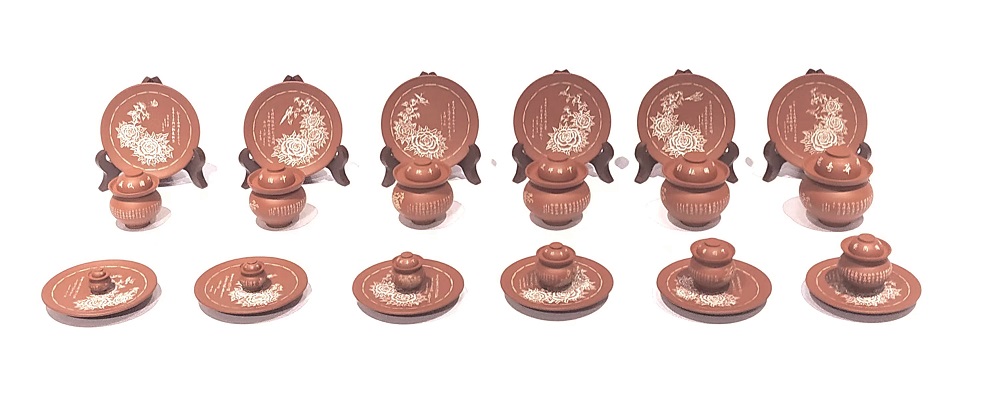Pottery Carvings to Spead Hometown Stories
荣昌陶刻 刀下见神韵

陶语堂出品的“荣昌陶器系列之作”入选2021“重庆好礼·外事礼品”。
Adding Brilliance to Pottery with Masterly Carving Technique
吴华生陶刻成竹在胸。
At Taoyutang, the studio of Master Wu Huasheng located in Antao Town, Rongchang, an impressive collection of pottery in various shapes is displayed alongside certificates of honor. Despite its modest size of only 20 square meters, the studio is home to hundreds of pottery works adorned with multifarious patterns, such as tiny landscapes, flowers, birds, insects, bamboo, and even full-length calligraphy introducing Rongchang pottery, one of China’s most renowned ceramic styles. The vivid and vibrant patterns imbue pottery works with traditional Chinese cultural aesthetics.
The Rongchang Pottery Series, produced by Taoyutang, was selected as the 2021 Chongqing Gifts for Foreign Affairs.
陶刻必须有较高的文化素养及艺术素养,以及扎实的运刀技巧。
Working at his workbench, Wu was engrossed in carving intricate patterns onto a pottery cup. With deft and skillful maneuvers of his graver, he quickly completed a line of poetry and a picture of green bamboo.
As he carved the pottery, Wu introduced, “Pottery carving requires a sharp eye, a diligent mind, and skilled handicraft. It is important to conceive an overall design before beginning to carve.” “When carving calligraphy and painting works, Wu prefers not to make a rough draft, relying instead on his mastery of carving skills to create intricate and precise designs. With over 40 years of experience studying calligraphy, painting, seal carving, and pottery art, Wu has honed his skills to the point where he can easily carve patterns such as landscapes, flowers, birds, and figures, as well as calligraphy works in various styles including regular script, cursive script, clerical script, and seal script.
Pottery carving is a kind of unique workmanship characterized by using gravers to depict calligraphy and painting works on pottery in a way that enables the perfect fusion of pottery-making craft and traditional Chinese calligraphy and painting art. Wu believed that carving patterns derived from Chinese calligraphy and painting works onto simple and elegant Rongchang pottery can add cultural traits to these artifacts. “Such works can show cultural vitality and aesthetics, reflecting the essence of inheritance.”
Using a Graver to Speak His Mind
参选“重庆好礼”的陶刻葫芦。
“Becoming a sophisticated and confident carver requires first conceiving of artistic arrangements and then executing precise, appropriate, and neat carving,” Wu said. Creating a good pottery carving work demands a high level of artistic quality, a solid foundation in pottery carving, and considerable expertise in using gravers.
Wu has also applied his carving skills to jade, bamboo, stones, and other materials, always seeking out new and interesting objects to work with.
In 2019, Wu’s exquisite pottery carving, a tea set featuring micro scriptures carved both inside and outside, was acquired by the National Art Museum of China (NAMOC) for its collection. This carving represents the application of centuries-old character carving art to pottery.
Micro carving has become an exclusive of Wu, allowing him to apply traditional Chinese carving art to small utensils and highlight Chinese culture in intricate detail.
Wu showed a palm-sized teacup with inner walls carved with calligraphy characters, each of which is only 1 millimeter in size. “When it comes to micro-carving, it can be difficult to see the details of what has been carved, but I am confident that I can carve exactly what I have envisioned. Incorporating painting and calligraphy works into pottery works can renew their spirit,” Wu said.
To improve his carving technique, he has visited ceramic production areas nationwide many times in addition to self-study. In terms of making greenware, he is independent-minded in designing, and his works are favored by pottery enthusiasts.
Wu said a Taiwanese compatriot working in Chongqing visited Antao and discovered a favorite gift in his studio after exploring the town. Later, they established regular business contact.
Using Carvings to Introduce the Story of Rongchang Pottery
Rongchang pottery dates back to the Han Dynasty and became flourishing in Tang and Song dynasties. It has been acknowledged as one of the four most noted ceramic crafts in China, and has been listed among the country’s national-level intangible cultural heritage. Some of the pottery works look as red as dates, some are thin as paper, some have a bright, mirror-like finish, and some produce a chime-like sound.
“The history of Rongchang pottery runs deep, and I am eager to utilize my strengths to revitalize its cultural significance and increase its popularity.” To make Rongchang pottery visible to the world, Wu wrote the history of Rongchang pottery and carved it on the pottery.
“For example, this teacup features texts introducing the history of Rongchang pottery. As people savor their tea, they can learn about the rich history of Rongchang pottery from the very cups they hold. This is an excellent way to leave a favorable impression on people and promote the art form,” said Wu.
Sipping tea from a finely crafted Rongchang pottery cup, adorned with unique calligraphy and painting, can create a delightful and poetic experience.
Wu’s works have won the silver award at the Chinese Representative (4+N) Pottery Craft Competition, the silver award at the 54th National Crafts Trade Fair and 2019 “Golden Phoenix” Innovative Products Design Competition, the gold award at the 2021 “Chongqing Gifts” Cultural Creative Product Design Competition, and the gold award at the 10th China Ceramic Product Design Competition.
With honor comes the responsibility of cultural inheritance. For many years, Wu has generously passed his skills to anyone interested in learning the craft. “I hope that through the inheritance of techniques, pottery carving can serve as a bridge for Chongqing to contact with the wider world,” said Wu.
用刀如笔 陶刻添神韵
刻有“中国名陶荣昌陶”书法的茶壶。
走进位于荣昌安陶小镇的陶语堂吴华生大师工作室,一排排各形陶器和荣誉证书映入眼帘。这间约20平方米的工作室内,陈列着的数百件陶器,上面刻着各种各样的图案,有的是微型山水花鸟虫竹,有的是介绍“中国名陶荣昌陶”的长文书法,画面生动传神,形态自由驰骋,独具中国传统文化韵致。
其中,陶语堂出品的“荣昌陶器系列之作”入选2021“重庆好礼·外事礼品”。
工作台前,吴华生全神贯注,刻刀在他的手上飞快移动,刀起泥落,不一会儿功夫,一行小诗和一幅翠竹图就镌刻在了杯盏之上。
吴华生一边雕刻一边介绍说,“陶刻讲究眼到、心到、手到,用刀如笔,意在刀先。”他做陶刻书画一般都不打底稿,全靠对陶刻技艺的掌握。40多年来,他对书法、绘画、篆刻、陶艺等均有学习和研究,刻画山水、花鸟、人物,以及楷、草、隶、篆等各种书法,也是信手拈来。
陶刻是一种独特的工艺技法,其特点是以刀代笔,把书法、绘画以各种刀法技艺栩栩如生地传神于陶器上,使制陶工艺与中国传统书画艺术融为一体。吴华生认为,荣昌陶的陶壶、陶杯造型简约、古朴典雅,陶刻上的中国书画更为其增添了文化内涵,“这样的作品才得以彰显生机和韵味,才是真正意义上的传承。”
刀锋所及 是心中所想
微刻书法茶碗。
“陶刻要达到较高的境界,雕刻者必须胸有成竹,未落刀时构思布局已成。下刀准确而熟练,一刀起落就是笔画的起势收势,既要放得开,又要收得住,干净利落,一气呵成。”吴华生说,好的陶刻作品,制作者必须有较高的文化艺术素养、熟练的陶刻基础,以及扎实的运刀技巧。
吴华生不仅限于在陶器上雕刻,还在玉石、竹子、石头等各种载体上雕刻。用他的话来说,只要能够用来雕刻的东西,他都尝试过。
2019年,吴华生的“微刻心经”茶具,因雕刻手法采用微刻内外“刀书”的方式,把中国古老的刻字艺术运用在陶上,作品被中国美术馆收藏。
微刻,算是他的又一项绝活,将微小精细见长的传统雕刻艺术,与微型器皿融为一体,方寸之间彰显中国文化。
吴华生展示了一盏手掌大的茶杯,其内壁雕刻书法,每个字只有1毫米大小。“在细微的雕刻中,肉眼看不到自己刻了什么,刀锋所及之处便是心中所想。这种在陶器表面刻上书画,赋予了陶器新的生命。”吴华生说。
为了提升自己的陶刻技艺,他除了自己钻研实践,还多次前往全国各产陶区参观学习,提升陶刻技术。在制坯方面,他也加入自己的设计想法,其作品深得陶艺爱好者青睐。
吴华生称,曾经有一位在重庆工作的台湾同胞到安陶旅游,逛遍了整个小镇,最终在他的工作室选到了钟意的礼物。后来常来常往,便成了熟客。
以刀代笔 写荣昌陶故事
陶语堂各种陶刻陶器。
红如枣、薄如纸、亮如镜、声如磬的荣昌陶,兴起于汉代,繁荣于唐宋,是“中国四大名陶”之一,国家级非物质文化遗产。
“荣昌陶历史底蕴深厚,我希望发挥自己的优势,赋予它更多的文化色彩,提升荣昌陶的知名度。”为了让世界都能看到荣昌陶、了解荣昌陶,吴华生把荣昌陶的历史自撰成文,并刻在陶器上。
“比如这盏茶杯,上面就刻了一段荣昌陶的历史简介。当人们在品茶,手捧着茶杯,就可以了解荣昌陶的历史,让更多人喜欢荣昌陶。”吴华生说。
做工精良、料好形正的荣昌陶壶,配上独具神韵的陶刻书画,于岁月悠悠之时,诗意盎然之处,品茗赏壶,可谓人生惬意享受。
吴华生的作品曾获中国名陶技艺大赛银奖,第五十四届全国工艺品交易会暨2019“金凤凰”创新产品设计大赛银奖,2021“重庆好礼”文创产品大赛金奖,第十一届中国陶瓷产品设计大赛金奖……
荣誉的背后是文化传承的责任与担当。多年来,只要有人来学习,吴华生都慷慨传授,“希望通过陶刻技艺的传承,让荣昌陶成为重庆对外交流的窗口、连接外部的纽带、通往世界的桥梁。”吴华生说。
文/杨艳
重庆与世界杂志社 Copyright 2000-2023 Cqworld.cn All Rights Reserved. 渝ICP备:05006161/渝公网安备50010302504769号
国内发行:重庆市报刊发行局\杂志社自发 | 国外发行:中国国际图书贸易总公司
地址:重庆市渝中区学田湾正街1号广场大厦11F,举报电话:023-68898926,违法和不良信息举报中心热线:12377

微信公众号